Editorial
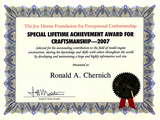
Well, it's birthday time once again and this is one of those ugly ones with a zero on the end of it. But any gloom that might attain from this has been more than offset by word that the Model Engine News website has received a Special Recognition Award from the Joe Martin Foundation for contributions to model engine builders, worldwide. This was totally unexpected and I still have a grin a mile wide. The award certificate may have my name on it, but the achievement itself was made by our little group with their dedication to sharing freely and openly. I could list their contributions, but it would start to sound like an Academy Award acceptance speech, so I'll go with a simple thanks guys!
 And since it's my birthday, Model Engine News Members get a present (the inverted logic must come from living 'downunder, I guess). As usual, it's a model engine plan and you can read about it in the Design Review news item. Producing this plan and revising a large chunk of the site has burned up all my shop time budget for the month, so things previously undone are now covered in cobwebs as well. And it's been bloody hot into the bargain (and still dry, but I was not going to mention that).
And since it's my birthday, Model Engine News Members get a present (the inverted logic must come from living 'downunder, I guess). As usual, it's a model engine plan and you can read about it in the Design Review news item. Producing this plan and revising a large chunk of the site has burned up all my shop time budget for the month, so things previously undone are now covered in cobwebs as well. And it's been bloody hot into the bargain (and still dry, but I was not going to mention that).
The cut-over to the new web server took place in the first week of February and was mostly painless. There have been a couple of outages, and the Editorial Page hit counter was offline for a while. But overall, performance seems much improved. If you've ever used the Site Search facility and been put off by how long it took to come back with some results, try it again. I think you'll find it quite speedy now. February stats were down on January, but we still got 12,000 unique visitors making 40,000 visits, reading 114,000 pages, causing a total of 1,100,000 hits. As usual, the bulk of the traffic originated in the USA, followed by the European Union, Australia, the UK, Canada, and just about every other country on the planet. The top count in "links from an external page" comes from a translation service. This indicates that all those countries where English is not the first language do more than just look at the pictures, which is truly gratifying. Now on to business, with another piece of sad news...
Vale: Arne Hende
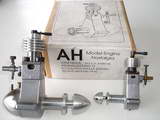
Sadly, Arne Hende left us during the past month. In case you are unaware, Arne made exquisite reproduction and reduced size replicas of well known and rare model engines in numbered, limited production runs, typically 100 each. All of these were produced to the same or better quality than the originals. An Arne Hende made engine will have his name or initials cast in someplace to distinguish it from the original, although many of his reproductions will command prices higher than the originals! His miniature reproductions are not just curios, they run like the proverbial Swiss watch—although Arne was proudly Swedish. The Motor Boys have dug through their collections of engines and engine photos to provide pictures of a good cross-section of his work. The Arne Hende Gallery page shows 22 different types, and this is by no means complete. Those who met him all speak of a friendly, highly approachable man. He and his talent will be missed.
New Stuff
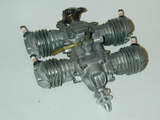
The best laid plans, etc. The page hit counters show that the page that has links to every page on this web site that has been added or modified during the past month has not got a lot of visitors. I'd like for this to be one of the first pages returning visitors go to every month to see which of their favourites (the Gallery, or the Watzits, whatever) has something new for them. It may take a while, so I've added a new item in the Regular Features heading to jog your memories. If that doesn't work, I'll have to get more cunning  .
.
More Bang for the Buck
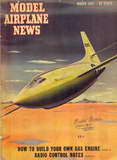
As I seem to keep harping on about, this web site continues to exist through the donations made by those who have bought the MEN Only CD or DVD. While everyone gets to see most pages, CD and DVD buyers become Members and get access to other pages including two free plans per year. In selecting the subject for this year's first free plan, an old sparkie called the Simplex 25 came to mind for a number of reasons. This engine appeared in Model Airplane News as a home construction series starting with the March 1947 issue. As I was busy being born while this issue was being sold, the Simplex makes the perfect subject for my annual, free, birthday give-away plan. MEN Members will find a very complete PDF file comprising five CAD drawings and 19 sheets of original instructions waiting for them in the password protected Members' section. The rest of you can order a set of plans, or join by buying the MEN DVD and get them for free. But wait! There's more...
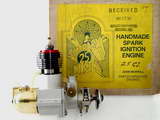 The original Simplex was intended by its designer, Louis Garami, as a project suitable for the beginner engine builder. So we can review the design features using the ideal first project design criteria established to identify what constitutes a good first engine project. Visit the Simplex 25 page to find out what I didn't like about it from this perspective. This review ends with a bonus. Just over thirty years after it first appeared, the Simplex design was refined and sold as limited production run Mk II by John Morrill. Hence we can extract even more bangs for our buck by looking at how John Morrill addressed my dislikes almost twenty years ago with his 1978 Mk II version.
The original Simplex was intended by its designer, Louis Garami, as a project suitable for the beginner engine builder. So we can review the design features using the ideal first project design criteria established to identify what constitutes a good first engine project. Visit the Simplex 25 page to find out what I didn't like about it from this perspective. This review ends with a bonus. Just over thirty years after it first appeared, the Simplex design was refined and sold as limited production run Mk II by John Morrill. Hence we can extract even more bangs for our buck by looking at how John Morrill addressed my dislikes almost twenty years ago with his 1978 Mk II version.
Links

Isn't that just the neatest thing? A bore gauge that only needs one hand to operate, not three! Even better, there's a size that's perfect for engines in the 1 to 10cc range. The set includes setting rings making it more than just a comparator, and it comes in a fitted wooden case making it just about irresistible to me. The supplier is a company called Long Island Indicator Service. This site has been added to the Links Page.
 While talking about the Links page, recall that last month, the links were reorganized and a new section containing a list of links to Unusual IC Technologies was added. This month, there's a new link in that section, and you might like to have a special look at an older one, namely the Beare Technology web site. For reasons I won't go into right now, this design was brought to my attention during the past month and I'm happy to say that Malcolm Beare is hard at work, producing significant results along with some perplexing questions. Well worth the time to visit and read about how he and the team are overcoming obstacles both technical and otherwise.
While talking about the Links page, recall that last month, the links were reorganized and a new section containing a list of links to Unusual IC Technologies was added. This month, there's a new link in that section, and you might like to have a special look at an older one, namely the Beare Technology web site. For reasons I won't go into right now, this design was brought to my attention during the past month and I'm happy to say that Malcolm Beare is hard at work, producing significant results along with some perplexing questions. Well worth the time to visit and read about how he and the team are overcoming obstacles both technical and otherwise.
Broken Taps and Alum, Again
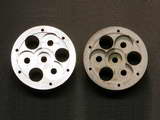
Apparently I'm not the only one to ever break a tap in a complex, mostly machined workpiece. Last month, we mentioned Jerry Howell's suggestion of using a solution of alum to dissolve steel from non-ferrous alloys. Two readers have emailed during the past month to report their experience with this approach. First the good news, both have managed to remove the tap. Now the gotcha: seems there's alum, then there's Alum. Our first reader tried "grocery store" alum and nothing happened at all. Undeterred, he tried some stuff obtained from eBay and was able to remove the tap after the teeth had been eaten away. But as can be seen in the accompanying photo (of an RAW Triscamp radial), the case was severely discolored and lightly etched by the process. The other reader had no such problem. Prudence (an old girlfriend) says try out your alum solution on a scrap of the same alloy first to see if you are willing to live with the result before taking the final plunge.
Motor Boys' Book: Price Reduction
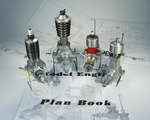
It's official: Wendy Wisehart, the Product Guide Coordinator for the AMA has let me know that the Motor Boys' Plan Book has been reduced in price to a stunning US$19.95! With 12 complete plans in the book, that's about $2 per set after you include postage. Corrections to the plans can be downloaded from this website making the effective value even greater. Now even though this looks like biased self-promotion, we have not and never will receive anything but warm feelings from sales as all proceeds go to assisting juniors. Click on the Photo to read more...
Unusual Engines on-line
Last month I mentioned the column on unusual internal combustion engines that has become a regular feature in Model Engine Builder magazine. In the past month, I've had an enjoyable email exchange with the author of that series, Ron Cairns. In response to my concern that he might run out of material, Ron assured me that as a consequence of collecting alternatives to the Otto cycle for about 25 years, he has about 390 engines that are waiting patiently for him to write about! For the past three years, Ron Cairns has also been writing about alternative engine technology in Pro Trucker magazine. They have recently placed some of his writings on-line: check out Otto Alternates and Diesel Diversions. Although not as detailed as his MEB series, they sure provide food for thought. He has also provided a new link for the Unusual Engines section of the Links Page.
New Books and Magazines This Month
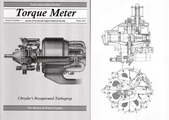
The Library received two unexpected but welcome additions this past month. First to arrive was the first issue in volume six of Torque Meter from the Aircraft Engine Historical Society. This issue is of particular significance to me, as it contains a very well researched and illustrated article on the Mawen differential rotary by Dennis Sparks (which is why AEHS President, Kim McCutcheon, kindly sent it to me). Model Engine News readers will have seen some of Dennis' pictures of this unusual engine in the October 2004 issue. The TM article is the result of Dennis' research into this engine and its predecessors. He's even kind enough to include Model Engine News in the acknowledgements that accompany the piece.
The magazine is published quarterly and contains 48 pages. This issue comes with a wonderful centerfold: a cut-away drawing of the 1914 Renault 70 HP V-8. This an earlier Renault to the one Major Halford cut in half to produce the Cirrus Mk I as evidenced by the unusual valve arrangement: overhead poppet exhaust with vertically opposed side-valve inlet! What a wonderful model subject this would make, even just a single pot version. The other articles and regular columns in the issue were good reading too. I especially like Kevin Cameron's ATDC observations about the modern tendency to design by committee. I really should re-subscribe to TM. If you love aero engines, so should you. Single and past volumes are available; visit the AEHS web site for details.
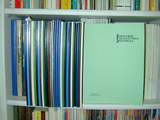
The next unexpected arrival was Volume 31 of the Engine Collectors' Journal. In case you are wondering what 30 bound volumes of ECJ looks like, here's that shelf of The Library with the ECJ volumes pulled out a bit (they start at Volume #2 which is when Tim Dannels took over from the earlier Model Engine Collector). Each volume contains six issues; those in Vol 31 are numbered 175 through 180 and cover the period February 2006 to January 2007. ECJ comes out when it comes out, but I've noticed that Tim has maintained a more regular publishing schedule in recent years, probably reflecting the flow of material from his contributors. As well as Roger Schroeder's regular Engine-uity column, you get articles on little known sparkies like the Dreadnaught and Wally Scouts, plus features on the original Technopower radials, Weiss/Loutrel (forerunner to the infamous GHQ), and many more. ECJ #176 (second in the volume) marks a subtle and un-remarked upon change in format for the cover. The engine picture is now rendered in color on the usual graduated color background. It's a nice touch. Volume 31 is US$17.50 and most back volumes are available. Visit the website from the hyperlink above to place your order now!
Beginner Designs Revised
Some of the good ideas on this site go sour over time—mostly because I didn't apply sufficient thought to them in the first place. Such is the case with the page dedicated to analysing what constitutes a good engine for the first time model IC engine builder. Put simply, placing all the reviews on a single page just does not scale for use on the web. Hence, the page has been split into a Discussion page that then references individual design review pages. In the process, the introductory discussion has been expanded, as have several of the design reviews. There were six such reviews, but now there are seven, as we'll see in the next item.
Engine Of The Month: Morton M42
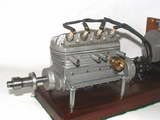
This is another of those reviews that started as some photos sent in by a kind reader (whose email I've unaccountably lost) which were going to get minimal treatment. But as I dug into what is known about the Morton in-line engines, words seemed to magically accumulate and before I knew it, the minimal treatment had become something approaching a full review. In summary, ther are no Morton 4's, 42's, not 4 two-strokes in existence, but there are "Morton" 4's, 42's and 4 two-strokes made by talented builders who have overcome the limitations of the factory concept. Click the M42 picture for the story.
Tech Tip of the Month
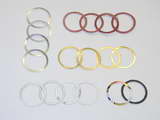
There will be times when the low-tech way of making gaskets just don't cut it, (pun intended  ), like when you have to make them from metal, or make a lot of them to very precise sizes. The answer is to make a punch and die, just like the big boys. This month's tip describes how you might go about making the required punch and die for a simple, circular gasket with the absolute minimum amount of work (I'm lazy) and then abuse your normal workshop equipment (I'm cheap, too) to bash out a gasket or ten. Visit the How-to Index, or leap direct to the Punch and Judy page.
), like when you have to make them from metal, or make a lot of them to very precise sizes. The answer is to make a punch and die, just like the big boys. This month's tip describes how you might go about making the required punch and die for a simple, circular gasket with the absolute minimum amount of work (I'm lazy) and then abuse your normal workshop equipment (I'm cheap, too) to bash out a gasket or ten. Visit the How-to Index, or leap direct to the Punch and Judy page.
 Vale: Arne Hende
Vale: Arne Hende
 New Stuff
New Stuff
 More Bang for the Buck
More Bang for the Buck
 Links
Links
 Broken Taps and Alum, Again
Broken Taps and Alum, Again
 Motor Boys' Book: Price Reduction
Motor Boys' Book: Price Reduction
 Unusual Engines on-line
Unusual Engines on-line
 Beginner Designs Revised
Beginner Designs Revised
 Editorial
Editorial
 New and Updated Pages
New and Updated Pages
 New Books and Magazines This Month
New Books and Magazines This Month
 Engine Of The Month: Morton M42
Engine Of The Month: Morton M42
 Tech Tip of the Month
Tech Tip of the Month
 New Stuff This Month
New Stuff This Month
 Standard Stuff
Standard Stuff

 And since it's my birthday, Model Engine News Members get a present (the inverted logic must come from living 'downunder, I guess). As usual, it's a model engine plan and you can read about it in the
And since it's my birthday, Model Engine News Members get a present (the inverted logic must come from living 'downunder, I guess). As usual, it's a model engine plan and you can read about it in the 

 .
.









